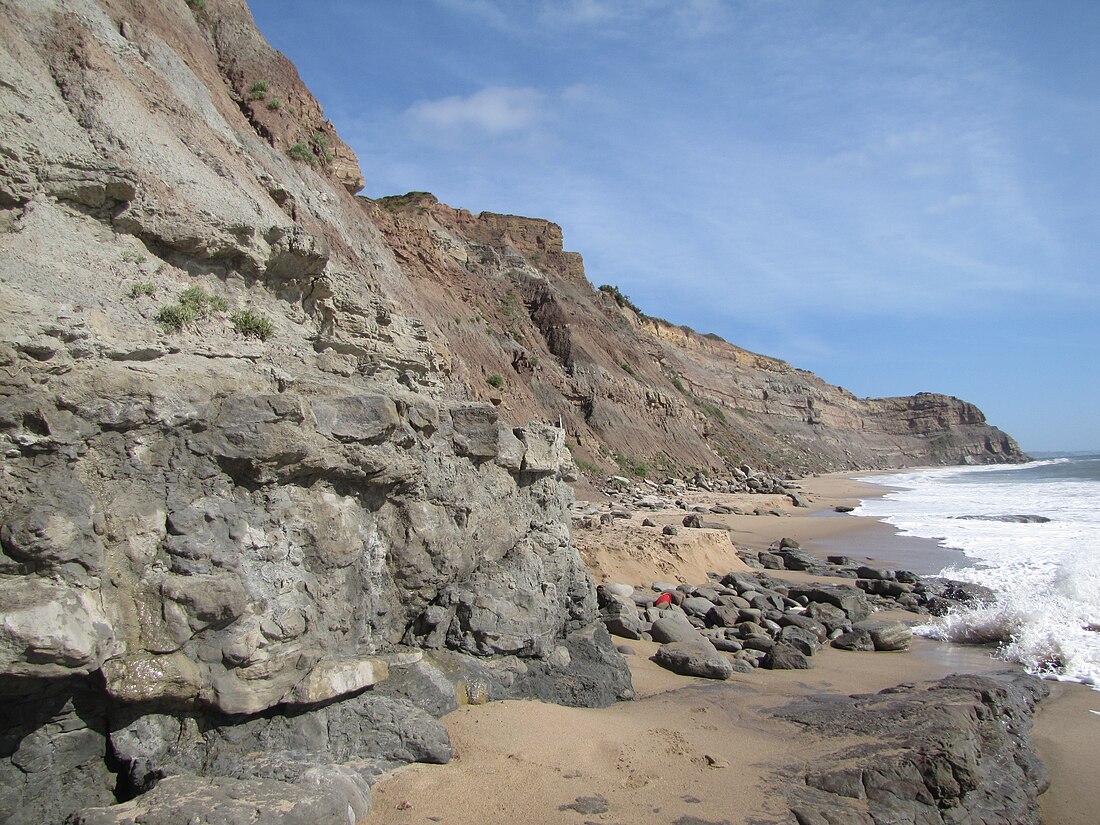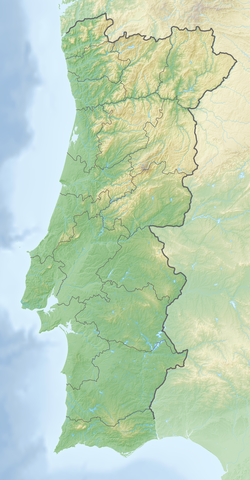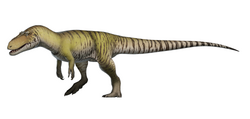Top Qs
Timeline
Chat
Perspective
Lourinhã Formation
Late Jurassic geological formation in Portugal From Wikipedia, the free encyclopedia
Remove ads
The Lourinhã Formation (Portuguese pronunciation: [loɾiˈɲɐ̃] ⓘ) is a fossil-rich geological formation in western Portugal, named for the municipality of Lourinhã. The formation is mostly Late Jurassic in age (Kimmeridgian/Tithonian), with the top of the formation extending into the earliest Cretaceous (Berriasian). It is notable for containing a fauna especially similar to that of the Morrison Formation in the United States and to a lesser extent to the Tendaguru Formation in Tanzania. There are also similarities to the nearby Villar del Arzobispo Formation and Alcobaça Formation. Besides the fossil bones, Lourinhã Formation is well known for the fossil tracks and fossilized dinosaur eggs.[1][2]
The Lourinhã Formation includes several lithostratigraphic units, such as Praia da Amoreira-Porto Novo Members, Praia Azul Member, the Santa Rita Member, and the Assenta Member.[3] The stratigraphy of the formation is complex and controversial, with the constituent member beds belonging to the formation varying between different authors.[4]
Remove ads
Lithology and depositional history
Summarize
Perspective
Depositional history

The Lourinhã Formation is located within the Lusitanian Basin, a mostly onshore North South orientated rift basin within western Portugal, formed during the Opening of the North Atlantic Ocean, with sediment deposition beginning during the Late Triassic-Early Jurassic. It primarily consists of syn-rift near-coastal continental siliciclastic sediments, with several marine intercalations. The primary flow direction was North to South, originating from Galicia and flowing between the Iberian landmass to the east and the now largely submerged Berlengas horst, a north–south oriented ridge, to the west.
The Lourinha Formation is interpreted as being an island, separated by North America and the rest of Europe by marine barriers.[5] The Paleoclimate is interpreted as being semi arid, with less than 50 cm of annual precipitation and an average annual temperature of 16 to 19 °C.[4]
Stratigraphy
The unit was first formally proposed by Hill in 1988.
The stratigraphy of the Lourinhã Formation is complex and varies between sub-basins with several competing stratigraphic proposals and there is currently no consensus on the matter, one of the most recent stratigraphies,[4] divides the formation into three members which are from oldest to youngest the Praia da Amoreira-Porto Novo Member, Praia Azul Member, and the Assenta Member.
Praia da Amoreira-Porto Novo Member
The Praia da Amoreira-Porto Novo Member is composed of the Priaia de Amoreira Member, which consists of massive mudrock-sand with metre thick sandstone lenses, with massive mudrock with calcrete. The overlying Poto Novo Mb. consists of massive bodies of sandstone, often cross bedded. The environment of deposition is interpreted as a meandering fluvial system, while the Porto Novo Mb is interpreted as a deltaic deposit. It is interpreted to be latest Kimmeridgian in age, and overlies the Consolacao Unit at the top of the Aulacostephanus eudoxus ammonite zone.[4][6]
Praia Azul Member
The Praia Azul Member, formerly known as the Sobral unit/member is 80 to 130 metres thick and consists of tabular marls and mudstones, with rare sandstones bodies. There are three distinct laterally extensive (>20 km) thin shelly carbonate horizons within this member, indicating brief marine transgressions. South of Santa Cruz primarily consists of sandstone with rare conglomerate. The age is considered to be latest Kimmeridgian to earliest Tithonian, correlated to the ammonite zones of Hybonoticeras beckeri and Hybonoticeras hybonotum.[4][6]
Santa Rita Member + Assenta Member
The Santa Rita Member in the Consolação sub-basin and its lateral equivalent in the Turcifal Basin the Assenta Member is around 300 metres thick and predominantly consists of mudstones with frequent layers of caliche. Near the top of the member several layers of tens of metres thick nodular and marly bioclastic limestones are present, containing marine benthic forams, the nodularity is derived from intense Thalassinoides burrowing. It is predominately late Tithonian in age, with the last few metres probably being earliest Berriasian, with the top of the formation roughly correlative with the base of the magnetochron M18n. (~144.7 Ma)[7][4] The environment of deposition is interpreted as being an upper fluvial-dominated delta to meandering fluvial systems flowing on a paralic plain.
Remove ads
Fauna
Summarize
Perspective
Dinosaurs
In a 2003 study, an analysis of all Portuguese dinosaurs was published. The study created a cladogram showing the possible relations of all Portuguese dinosaurs, including those at the time known from the Lourinhã Formation.[8]
Ornithischia
Color key
|
Notes Uncertain or tentative taxa are in small text; |
Ornithopods
Color key
|
Notes Uncertain or tentative taxa are in small text; |
Thyreophorans
Color key
|
Notes Uncertain or tentative taxa are in small text; |
Other Ornithischians
Saurischia
Color key
|
Notes Uncertain or tentative taxa are in small text; |
Sauropods
Theropods
Pterosaurs
Mammaliaformes
Docodonta
Cladotheria
Multituberculata
Amphibians
Squamates
Crocodyliformes
Fish
Remove ads
Flora
Correlation
Remove ads
See also
References
External links
Wikiwand - on
Seamless Wikipedia browsing. On steroids.
Remove ads



















